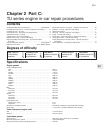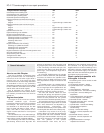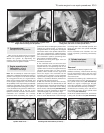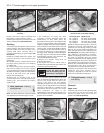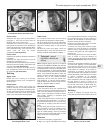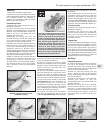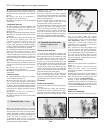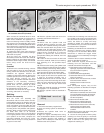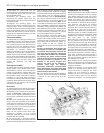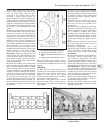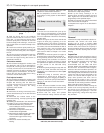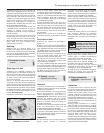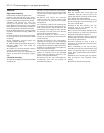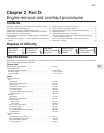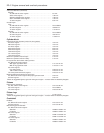
which contact the camshaft lobes for wear
ridges and scoring. Renew any rocker arms on
which these conditions are apparent. If a
rocker arm bearing surface is badly scored,
also examine the corresponding lobe on the
camshaft for wear, as it is likely that both will be
worn. Renew worn components as necessary.
The rocker arm assembly can be dismantled as
described in paragraphs 4 and 5.
11 Inspect the ends of the (valve clearance)
adjusting screws for signs of wear or damage,
and renew as required.
12 If the rocker arm assembly has been
dismantled, examine the rocker arm and shaft
bearing surfaces for wear ridges and scoring.
If there are obvious signs of wear, the relevant
rocker arm(s) and/or the shaft must be
renewed.
Camshaft
13 Examine the camshaft bearing surfaces
and cam lobes for signs of wear ridges and
scoring. Renew the camshaft if any of these
conditions are apparent. Examine the
condition of the bearing surfaces, both on the
camshaft journals and in the cylinder head. If
the head bearing surfaces are worn
excessively, the cylinder head will need to be
renewed. If the necessary measuring
equipment is available, camshaft bearing
journal wear can be checked by direct
measurement, noting that No 1 journal is at
the transmission end of the head.
14 Examine the thrust fork for signs of wear
or scoring, and renew as necessary.
Refitting
Rocker arm assembly
15 If the rocker arm assembly was
dismantled, refit the rocker shaft to the left-
hand pedestal, aligning its locating hole with
the pedestal threaded hole. Refit the grub
screw, and tighten it securely. With the grub
screw in position, refit the cylinder head cover
mounting stud to the pedestal, and tighten it
securely. Apply a smear of clean engine oil to
the shaft, then slide on all removed
components, ensuring each is correctly fitted
in its original position. Once all components
are in position on the shaft, compress the
right-hand pedestal and refit the circlip.
Ensure that the circlip is correctly located in
its groove on the shaft.
16 Refit the cylinder head and rocker arm
assembly as described in Section 11.
Camshaft
17 Ensure that the cylinder head and
camshaft bearing surfaces are clean, then
liberally oil the camshaft bearings and lobes.
Slide the camshaft back into position in the
cylinder head. On carburettor engines, take
care that the fuel pump operating lever is not
trapped by the camshaft as it is slid into
position. To prevent this, remove the fuel
pump before refitting the camshaft, then refit
it afterwards.
18 Locate the thrust fork with the left-hand
end of the camshaft. Refit the fork retaining
bolt, tightening it to the specified torque
setting.
19 Ensure that the housing and cylinder head
mating surfaces are clean and dry, then apply a
smear of sealant to the housing mating surface.
Refit the housing to the left-hand end of the
head, and securely tighten its retaining bolts.
20 Lubricate the lips of the new seal with
clean engine oil, then drive it into position until
it seats on its locating shoulder. Use a
suitable tubular drift, such as a socket, which
bears only on the hard outer edge of the seal.
Take care not to damage the seal lips during
fitting. Note that the seal lips should face
inwards.
21 Refit the camshaft sprocket as described
in paragraphs 17 to 19 of Section 8.
22 Refit the cylinder head as described in
Section 11.
11 Cylinder head - removal and
refitting
4
Removal
1 Disconnect the battery negative lead.
2 Drain the cooling system as described in
Chapter 1.
3 Remove the cylinder head cover as
described in Section 4.
4 Align the engine assembly/valve timing
holes as described in Section 3, and lock both
the camshaft sprocket and flywheel in
position. Do not attempt to rotate the engine
whilst the tools are in position.
5 Note that the following text assumes that
the cylinder head will be removed with both
inlet and exhaust manifolds attached; this is
easier, but makes it a bulky and heavy
assembly to handle. If it is wished to remove
the manifolds first, proceed as described in
the relevant Part of Chapter 4.
6 Working as described in the relevant Part of
Chapter 4, disconnect the exhaust system
front pipe from the manifold. Where fitted,
disconnect or release the oxygen sensor
wiring, so that it is not strained by the weight
of the exhaust.
7 Remove the air cleaner assembly and inlet
ducts as described in Chapter 4.
8 On carburettor engines, disconnect the
following from the carburettor and inlet
manifold as described in Chapter 4A:
a) Fuel feed and return hoses (plug all
openings, to prevent loss of fuel and the
entry of dirt into the system).
b) Throttle cable.
c) Choke cable (where applicable).
d) Carburettor idle fuel cut-off solenoid
wiring connector(s).
e) Vacuum servo unit vacuum hose, coolant
hose and all other relevant
breather/vacuum hoses from the
manifold.
9 On fuel-injected engines, carry out the
following operations as described in Chapter
4B:
a) Depressurise the fuel system, and
disconnect the fuel feed and return hoses
from the throttle body (plug all openings,
to prevent loss of fuel and entry of dirt
into the fuel system).
b) Disconnect the throttle cable.
c) Disconnect the relevant electrical
connectors from the throttle body.
d) Disconnect the vacuum servo unit hose,
coolant hose(s) and all the other
relevant/breather hoses from the
manifold.
10 Remove the centre and upper timing belt
covers as described in Section 6.
11 Loosen the timing belt tensioner pulley
retaining nut. Pivot the pulley in a clockwise
direction, using a suitable square-section key
fitted to the hole in the pulley hub, then
retighten the retaining nut.
TU series engine in-car repair procedures 2C•9
2C
10.8 Undo the retaining bolt and remove
the camshaft thrust fork (arrowed) . . .
10.9a . . . prise out the oil seal . . . 10.9b . . . and slide out the camshaft



